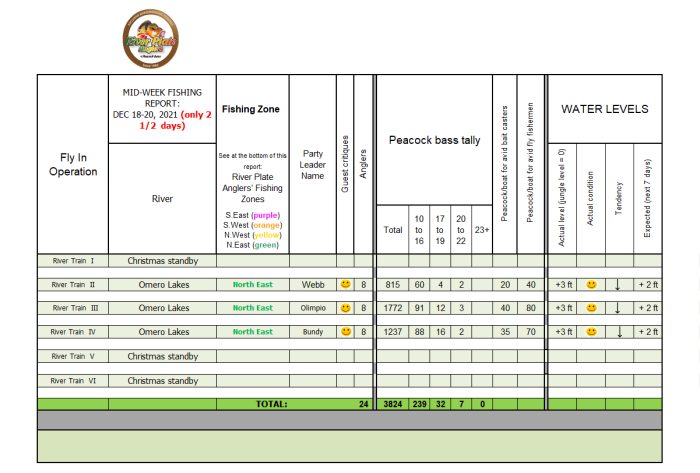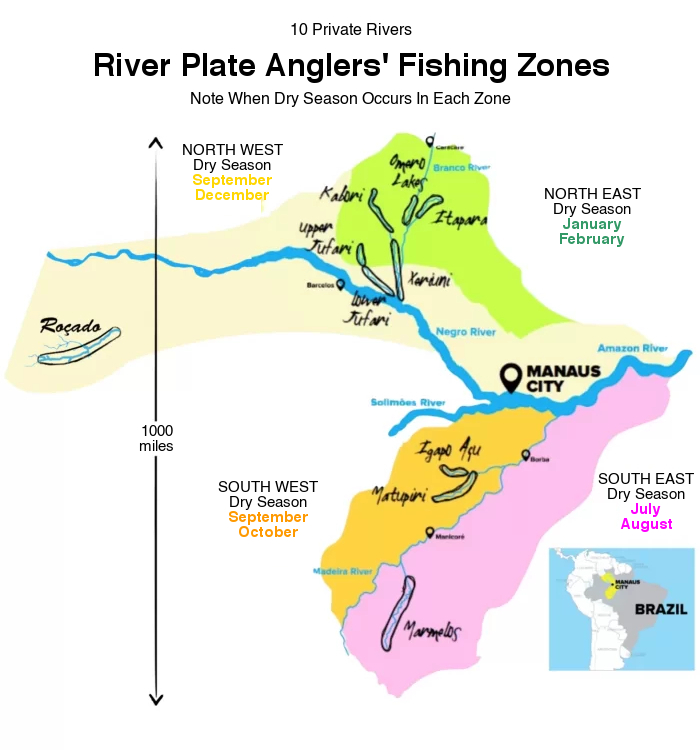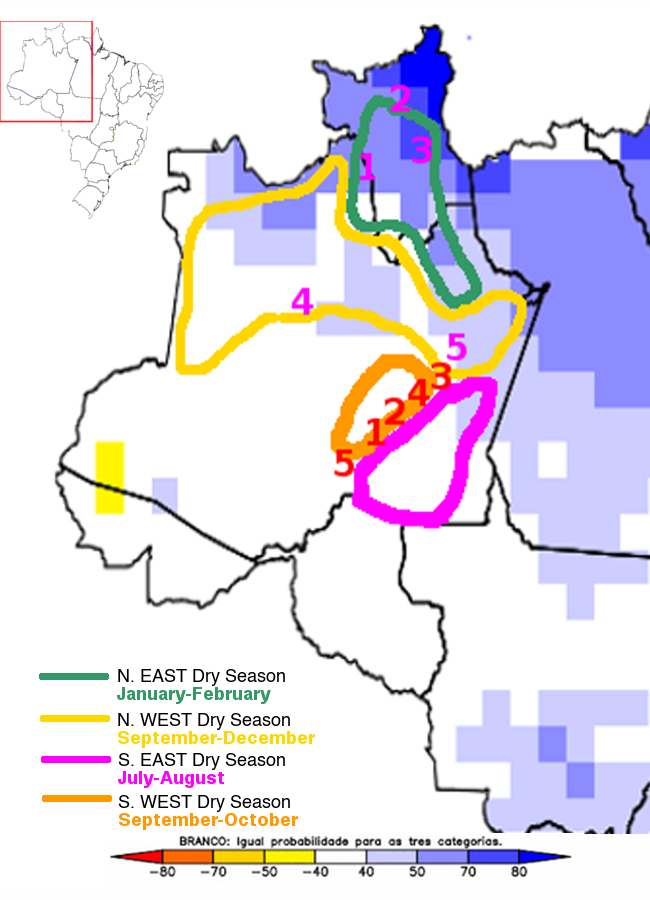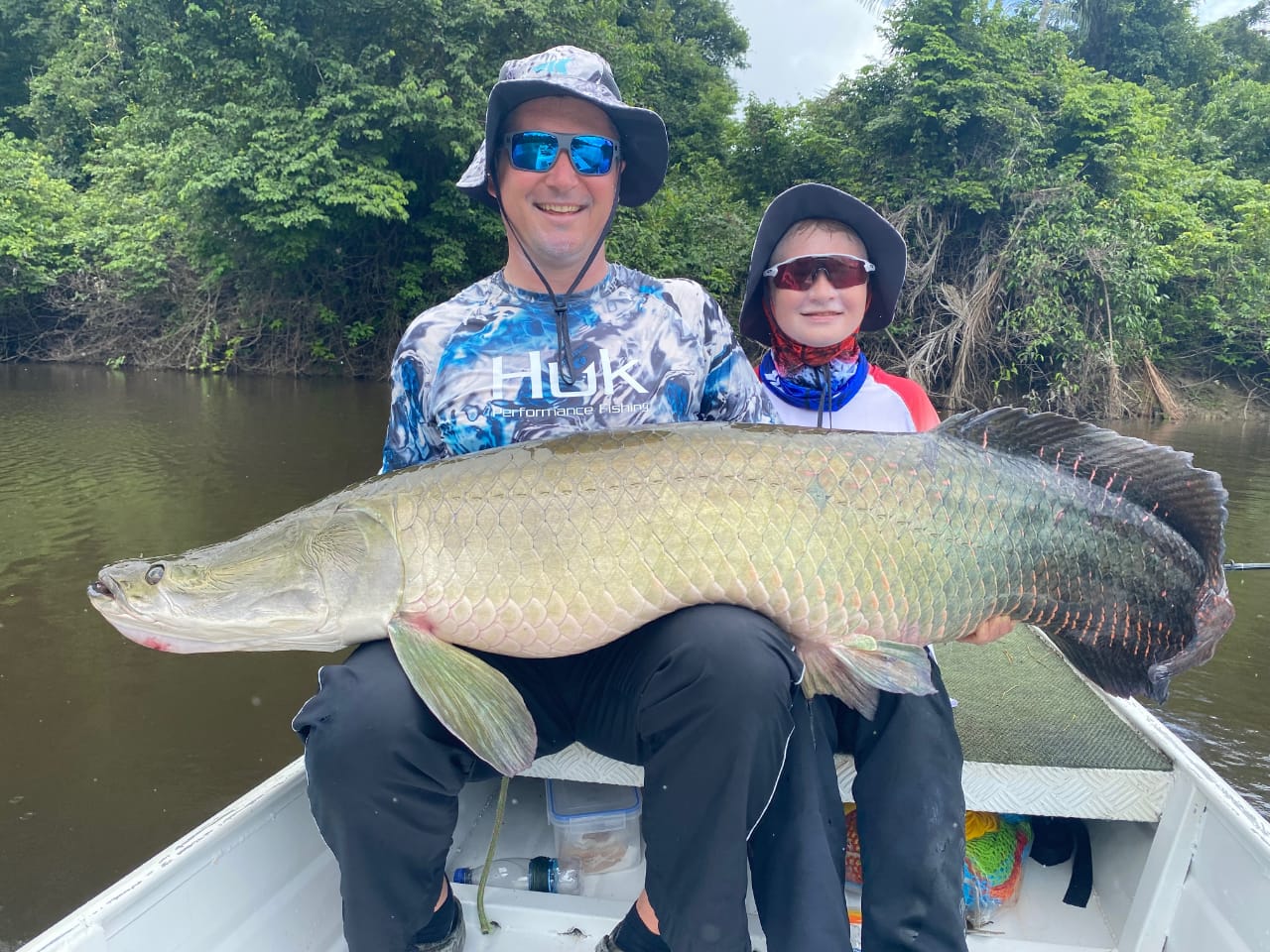Month: December 2021
Fishing Report: December 28th, 2021
HONEY HOLE….
3,834 Peacocks by 24 anglers
Our last 24 anglers before the year-end had excellent fishing at our private Omero lakes, despite high waters across the Amazon South American basin. Seven trophies were landed between 20 and 22 lbs.
Stats: The last 24 anglers for the year caught in 6 ½ days 3,834 peacocks with 239 peacocks between 10 and 16 lbs.; 32 between 17 and 19 lbs.; and 7 between 20 and 22 lbs.( see the above chart)
This tally excludes a multifarious array of tropical species landed such as jacundá, apapá, cachorra, oscar, aruana, wolfish, pacú, bicúda, and pirañha.
 (click on the table to see it at full size)
(click on the table to see it at full size)
Guesswork:
Below we wish to inform our incoming anglers about the six River Train destinations, according to the expected water levels across our 9 Private Rivers.
South West Zone & South East Zone (scroll down to see map): Water levels are all high from Manaus down to 500 miles south, which is normal this time of the year.
 We have transferred all River Trains 300-400 miles North of Manaus to the North East Dry Zone were water levels and fishing have been excellent on the Omero.
North East Zone (Omero, and the upper Jufaris, Itapara, Xeurini. Scroll down to see map): A couple of these rivers will continue to have excellent fishing for at least the next 1-2 weeks since water levels should be dropping as evidenced by todays and last week’s 10-Day Accumulated Rainfall Forecast. Scroll down to see these forecasts.
We have transferred all River Trains 300-400 miles North of Manaus to the North East Dry Zone were water levels and fishing have been excellent on the Omero.
North East Zone (Omero, and the upper Jufaris, Itapara, Xeurini. Scroll down to see map): A couple of these rivers will continue to have excellent fishing for at least the next 1-2 weeks since water levels should be dropping as evidenced by todays and last week’s 10-Day Accumulated Rainfall Forecast. Scroll down to see these forecasts.


 We have transferred all River Trains 300-400 miles North of Manaus to the North East Dry Zone were water levels and fishing have been excellent on the Omero.
North East Zone (Omero, and the upper Jufaris, Itapara, Xeurini. Scroll down to see map): A couple of these rivers will continue to have excellent fishing for at least the next 1-2 weeks since water levels should be dropping as evidenced by todays and last week’s 10-Day Accumulated Rainfall Forecast. Scroll down to see these forecasts.
We have transferred all River Trains 300-400 miles North of Manaus to the North East Dry Zone were water levels and fishing have been excellent on the Omero.
North East Zone (Omero, and the upper Jufaris, Itapara, Xeurini. Scroll down to see map): A couple of these rivers will continue to have excellent fishing for at least the next 1-2 weeks since water levels should be dropping as evidenced by todays and last week’s 10-Day Accumulated Rainfall Forecast. Scroll down to see these forecasts.


South West Zone > 10-Day Accumulated Rainfall Forecasts are for the towns marked in orange below, which affect water levels on the Matupiri and Igapo-Acu where we fished up until November. The accumulated rainfall over 2 inches means water levels will rise; between 1.5 and 2 inches means that water levels may drop slowly. On the other hand, rainfall between 1.5 and 1.0 inches means that levels will drop rapidly. Since the average is substantially above two inches, water levels will continue to rise, which is normal for this time of the year.
Today’s 10-Day Accumulated Rainfall Forecast is as follows:
- Manicore: 4.49 inches (marked as “1” in the 3 Month Rain Forecast Map below)
- Novo Aripuana: 4.17 inches (idem “2”)
- Autazes: 3.26 inches (idem “3”)
- Borba: 3.31 inches (idem “4”)
- Humaita: is outside our fishery sphere-of-influence (idem “5”)
- Caracarai: 1.12 inches (marked as “1” in the 3 Month Rain Forecast Map below)
- Boa Vista: 0.51 inches (idem “2”)
- Rorainopolis: 1.34 inches (idem “3”)
- Barcelos: 1.98 inches (idem “4”)
- Manaus: 3.64 inches (idem “5”) is outside our fishery sphere-of-influence. Used only as a reference.
- Caracarai: 1.19 inches (marked as “1” in the 3 Month Rain Forecast Map below)
- Boa Vista: 0.48 inches (idem “2”)
- Rorainopolis: 1.34 inches (idem “3”)
- Barcelos: 2.44 inches (idem “4”)
- Manaus: 3.79 inches (idem “5”) is outside our fishery sphere-of-influence. Used only as a reference.
- Caracarai: 3.57 inches
- Boa Vista: 2.13 inches
- Rorainopolis: 3.25 inches
- Barcelos: 2.86 inches
- Manaus: 4.17 inches (outside our fishery sphere-of-influence). Used only as a reference.
3-Month Rain Anomaly Forecast In Our Four Fishing Season Zones
(Valid for December-January-February)

Source: CPTEC/INPE, Brazil
In the map above, the white color means normal rainfall forecasted. Note that our selected fishing area during January and February, which is the North East Zone, is in light blue, meaning that there is a slight positive anomaly; i.e.: this zone should receive slightly more rainfall than expected for this time of the year. However, by Today’s 10-Day Accumulated Rainfall Forecast shows that areas (towns) 1, 2 and 3 have low expected rainfall.









